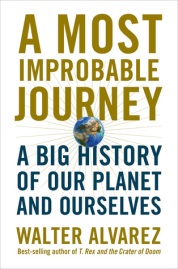Against All Odds: A geologist revels in the unlikely reality of life on Earth November 4, 2016
Posted by Jill S. Schneiderman in book review, history of science, science.trackback
This post reproduces a book review that I wrote for Science. (4 NOVEMBER 2016 • VOL 354 ISSUE 6312).

W hen esteemed geologist Walter Alvarez and his colleagues searched the lowlands of Eastern Mexico for ancient debris that had been ejected from the Chicxulub impact crater, they were following in the footsteps of renowned early-20th-century paleontologist Charles Doolittle Walcott. In his own time, Walcott wandered the Canadian Rockies seeking Cambrian-aged fossils that could shed light on this crucial time period when multicellular life began to flourish. As recounted in his obituary, “One of the most striking of Walcott’s faunal discoveries came at the end of the field season of 1909, when Mrs. Walcott’s horse slid in going down the trail and turned up a slab that at once attracted her husband’s attention. Here was a great treasure—wholly strange Crustacea of Middle Cambrian time…. Snow was even then falling, and the solving of the riddle had to be left to another season.” Serendipity combined with persistence eventually led Walcott to one of the most important discoveries in the history of geology—the softbodied fauna of the Burgess Shale.
In the case of the Alvarez group, two broken jeeps on the last day of the field season of 1991 nearly prevented the researchers from reaching the strange sand bed that Alvarez had chanced to read about in a book about the geology of the region published in 1936. As they “bounced along the rough road following the Arroyo el Mimbral, worrying as the Sun got lower in the sky,” they came upon a layer of glass spherules exposed in a steep bluff along the dry river bed. They suspected that the spherules were droplets of impact melt—“the most wonderful outcrop I have seen in five decades as a geologist,” writes Alvarez in his new book, A Most Improbable Journey: A Big History of Our Planet and Ourselves.
Alvarez is best known for helping to establish that a meteor struck the Yucatán, causing the mass extinction of half the genera of animals on Earth. In A Most Improbable Journey, he tells the story of the cosmos, Earth, life, and humanity using the interdisciplinary approach of Big History, which combines traditional historical scholarship with scientific insights. Alvarez aims to instill in his readers a sense of wonder that, despite enormous odds, there exists a planet (Earth) supremely suited for life. At the same time, he seeks to cultivate an expanded view of the nature of history, replete with contingency and consequent improbability, and to foster appreciation for the enormous stretches of time and space across which history has unfolded.
In each section of A Most Improbable Journey—“Cosmos,” “Earth,” “Life,” and “Humanity”—Alvarez uses both broad questions (have there been recognizable patterns, regularities, cycles, and contingencies in the history of continental motions?) and “little Big History” (how did the Spanish language come to dominate the Iberian Peninsula and then much of Latin America?) to help us comprehend “our whole situation.”
Throughout the book, Alvarez uses evocative phrases and images: History is “violent and chancy,” rocks “remember [their] history,” and mountains “are not wrecks—they are sculptures.” Compelling images of rock and architectural engravings, relief and sketch maps, and historical photographs and drawings enrich the discussion but, unfortunately, are not referred to directly in the text.
Alvarez invites his audience to read the book chapters in any order. Though I chose to read the book cover-to-cover, each chapter does indeed stand alone and therefore lends itself to this type of engagement. The book contains an appendix of resources that Alvarez annotates thoroughly, and it acts as an additional chapter that readers will likely enjoy perusing.
The paleontologist and historian of science Stephen Jay Gould wrote in an essay about the discovery of the Burgess Shale fauna, “So much of science proceeds by telling stories…. Even the most distant and abstract subjects, like the formation of the universe or the principles of evolution, fall within the bounds of necessary narrative” (1). In A Most Improbable Journey, Alvarez harnesses such narrative, enabling readers to experience the power of Big History.
REFERENCES 1. S.J. Gould,“Literary Bias on the Slippery Slope,” in Bully for Brontosaurus (Norton, 1992).
10.1126/science.aah5116
Comments»
No comments yet — be the first.